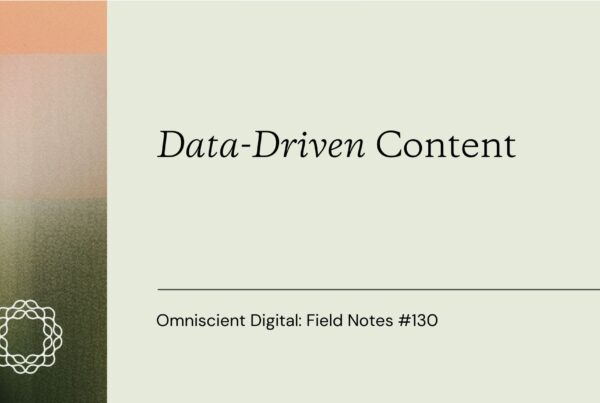
If you’re using the same SEO tactics that you were a few years ago, you’re not going to show up in the top search engine results.
Bernard Huang, the co-founder of Clearscope, says that the traditional approach to SEO of targeting keywords and building backlinks is no longer the way to signal to Google that your content is relevant.
To rank for your targeted keywords, you now need to show a depth of knowledge and a more sophisticated understanding of search intent.
Google monitors user engagement
A few years ago, a good starting place for deciding what keywords to target would be to compare keyword difficulty with your domain authority, but that’s no longer the right approach.
“High domain authority websites with weak content are starting to lack in performance,” Bernard said.
Using an example of a search for CBD teas, Bernard pointed out that the number three position result had zero backlinks and zero domains, but was able to rank for a fairly difficult keyword.
This example doesn’t stand alone. It’s become increasingly common over the last few years.
“What has been happening is that Google has been able to surface a lot better content and the way that they’ve been doing that is by measuring the user engagement signal that happens when somebody performs a search,” Bernard said.
From search engine results page to search engine results puzzle
“Over time, you’re seeing a search engine results page morph into a search engine results puzzle,” Bernard said.
Traditionally you’d expect to see top results for a search to be content that answers what a topic is and why it matters, but Google is now giving more weight to content that highlights experience viewpoints.
Using the CBD tea example again, the top two results were the benefits of CBD tea and the best five CBD products, but the next result is an experienced viewpoint.
“If you sort of followed more of a traditional keyword research approach, you might’ve just thought that you would be talking about 10 benefits of drinking CBD tea for anxiety,” Bernard said. “Yet you would have skipped over all of these other intents or viewpoints that the user is likely to care about.”
Focusing on search intent is key
The way to make sure that you don’t focus on the wrong piece of the topic you’re targeting is to understand search intent.
“The most important thing to understand about modern-day SEM and modern-day content strategy is that you want to create content that targets the relevant searching intents,” said Bernard. “By doing that, you’re actually then capable of winning the rankings for the head topics.”
For example, in a search for the keyword “bone broth,” a slow cooker bone broth recipe ranked number six. Why would a slow cooker recipe have such a high position for a broad keyword?
Because Google’s machine learning is figuring out what people will search for next and making it available in that first head topic search. People would search for bone broth and then immediately search for recipes next.
“You can imagine people were doing bone broth recipe searches, but they weren’t finding slow cooker bone broth recipes, so they had to perform an additional search,” Bernard said. “And because that happened over a long period of time, it trained Google to think that they should pull in some of the top-ranking results into that particular subtopic for bone broth recipe. Then over time, you see that targeting relevant search intents actually then gets you to the top for the head topic.”
How to fit into a SERP
If you want to improve your SERP ranking, do the following:
- Research the topics that you want to target using tools like Ahrefs, Google Search Console, and Clearscope.
- Identify the range of intents for each of those topics by Googling the keyword and seeing what content ranks highest.
- Figure out which topics to prioritize as within striking distance based on the domain authority of the sites in the top results.
If the intent is being surfaced by Google, then it’s very likely that’s a relevant idea or perspective that the user is going to care about.
“And if that domain authority is a lot lower than all of the other ones that are serving maybe the ‘what is’ intent that you typically see, then you’re able to actually fit yourself into the search engine results pages a lot faster because you’re displacing other intents that are from the lower domain authority websites,” said Bernard.
Once you have those steps completed, then you’ll move on to publishing comprehensive content on those topics and monitoring their performance.
Keyword research: spreadsheets are your friend
Let’s get into more detail about how to perform effective keyword research.
To figure out your list of target topics, use the tools mentioned above and look at the keywords your competitors are ranking for. Export that list into a spreadsheet.
Then look at the keyword explorer in your chosen tool like Ahrefs, add the seed keywords, and see what range of terms and questions it pulls up. Add those to your spreadsheet.
For example, if you’re doing keyword research for specific products of a clothing brand like tuxedos, you can go with seed keywords like men’s tuxedos, suits, tux, men’s formal wedding attire, etc. Once you’ve got the results, add those to your spreadsheet.
“What I’ll also do during this step is to go to my Google Search Console,” Bernard said. “Presuming that I already have an existing website, I would sort by the total number of impressions, export that to a Google Sheets to get the range of search queries that Google is already trying to give my domain.”
The last step is to use an optimization tool like Clearscope to get Google autocomplete suggestions and monthly search volume that comes from Google Ads Keyword Planner and add those to the spreadsheet and then delete any duplicates.
Deciding what to target to improve SERP rankings
Now for the fun part: finding the topics within striking distance.
“So we’re seeing all of these different fractures of intents that the user can care about,” Bernard said. “From there, we’re going to go and prioritize the striking distance search intents.”
You’ll want to Google each keyword and look at the domain rankings for the results to determine what to target. Find the results with weak domain authorities and high rankings.
“If we wanted to set ourselves up for a very high likelihood of placing or fitting into the search engine results page, it would make sense to prioritize the intents that are being ranked from lower domain authority websites,” Bernard said.
Once you pick out your striking distance intents, you can start to create content and work your way up the search results page.
Optimized content shows a depth of knowledge on a subject
Once you’ve picked out your topic, it’s time to focus on writing good, useful content.
Google’s algorithm now favors content that contains a depth of knowledge on a subject. They determine that by using a knowledge graph, which is a relational database of concepts.
For example, Google understands that when a piece of content is written about Tesla, one of the most popular models is the Tesla Model 3.
“More importantly, Google understands that the headquarters of Tesla is in Fremont or Palo Alto, and that belongs to the state of California. Therefore, if you created a piece of content that talked about Tesla, yet didn’t talk about the Model 3, Google might raise an eyebrow and say, ‘hmm, is that actually going to be a good piece of content’?” said Bernard.
By making sure your content includes all the necessary and relevant information on a topic, you give Google confidence that your content is actually going to meet the needs of the searcher.
One way to do this is to use a tool like Clearscope that gives recommendations of all the different pieces of information you should include when writing about a certain keyword.
For a piece on whether Zepbound is a good medication for diabetes and weight loss, the tool would suggest including information about side effects, dieting, and digestive health to make your content comprehensive.
Search intent changes over time
Unfortunately, once you’ve figured out the search intents and begun to rank for a particular keyword, you can’t just trust that your content will remain in a prime position.
One key thing that’s emerging in the new SERP landscape is people seeing themselves drop off the results page.
That’s because what people want to know about a topic evolves year over year.
“The main point that I want to make here is that search intent changes over time,” Bernard said. “When something first comes out as a novel concept, people are just simply going to want to know what it is, yet as society starts to learn more about it, they’re going to start to question whether or not that topic is good or bad.”
Once something is accepted as beneficial, like in the case of bone broth, people will want to know how to make it and you’ll see search intent fracture along those lines.
Not all hope is lost, though.
You can make sure you’re staying on top of search intent for keywords by checking Google Trends and seeing how the top results are changing over time. Then, make sure your content is reflecting that shift.


